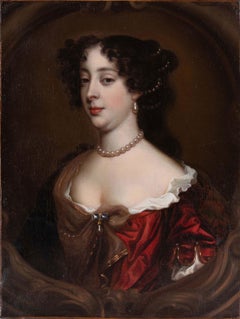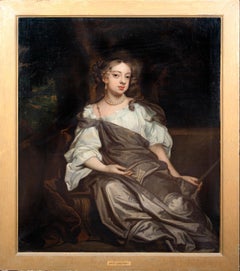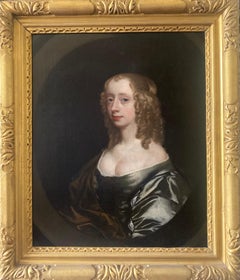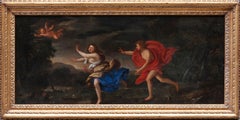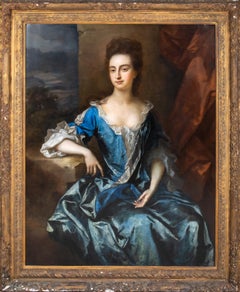Sir Peter Lely Paintings
Dutch, 1618-1680
Sir Peter Lely (1618-1680) was born in Germany at Soest in Westphalia in 1618. Though his family name was van der Faes, he assumed the name Lely after the lily that was carved on the gable of his father’s home in The Hague. He moved to England in 1641, the year that Van Dyck died, and succeeded Van Dyck. He was court painter to Kind Charles I and King Charles II. By working for many of the patrons of the late van Dyck, Lely rapidly established himself as one of the country’s most important portrait painters.to
3
1
1
2
Overall Width
to
Overall Height
to
4
4
4
4
4
1
1
4
4
2
2
4
781
712
705
691
4
4
Artist: Sir Peter Lely
Portrait of Barbara Palmer 1st Duchess of Cleveland
By Sir Peter Lely
Located in Taunton, GB
Portrait of Barbara Palmer 1st Duchess of Cleveland 1640-1709, half-length wearing a red dress and portrayed within a cartouche.
Circa 1680
Oil On...
Category
17th Century Sir Peter Lely Paintings
Materials
Oil
Portrait of Bridget Drury Lady Shaw, formerly Viscountess Kilmorey
By Sir Peter Lely
Located in London, GB
Sir Peter Lely (Soest 1618 – 1680 London)
Portrait of lady with a crown, possibly Bridget Drury Lady Shaw, formerly Viscountess Kilmorey, later Lady Baber (d.1696) c.1665
Oil on canvas
46 1/2 x 40 3/4 inches, Framed
42 1/4 x 36 1/4 inches, Unframed
Inscribed left [……….]Isabella
James Mulraine wrote the following for this piece:
This portrait dates to the middle of the 1660s, the decade when Lely’s career took off as successor to Sir Anthony van Dyck. At the Restoration Charles II had appointed him Principal Painter to the King and paid a pension £200 per annum ‘as formerly to Sr. Vandyke...’1 Lely had trained in Haarlem and he was in his early twenties when he came to London in 1643. He was an astute businessman and a wise courtier. In 1650 he painted a portrait of Oliver Cromwell (Birmingham Museum and Art Gallery) while maintaining links with the Royalist exiles through the 1650s. He had arrived in England as a painter of small-scale portraits and lush scenes of nymphs in landscapes in a Dutch style. His experience of Van Dyck in English collections transformed his painting. His lavish and alluring vision of Arcadia exactly captured the spirit of the Court and as Principal Painter he dominated English portraiture for the next twenty years. Lely ran a highly efficient studio along Netherlandish lines, employing a team of specialists like the drapery painter John Baptist Gaspars and young artists-in-training like Nicolas de Largilliere. He had numerous rivals during that period, and by 1670 he had introduced numbered standard poses to speed up production, while collaborating with printmakers for further revenue and advertising. He died in 1680 of a stroke while painting, working to the last.
The portrait, painted at a date when Lely’s poses and execution were still individual and inventive shows a lady sitting at three-quarter length facing away from the viewer. She has begun to turn towards the viewer, a pose with a long pedigree in art, first used by Leonardo da Vinci in the Mona Lisa (Louvre). She steadies her blue drapery where it might slip from her arm with the movement, a flash of realism beautifully captured. Like Van Dyck, Lely painted his female sitters in a timeless costume rather than contemporary fashion, showing a loose gown and floating silk draperies. It presented the sitter as a classical ideal. The portrait would not date.
The saffron dress may be the work of a drapery painter but the brown scarf must be by Lely himself, and appears unfinished, broadly sketched in behind the shoulder. The delicate blue glaze and nervous highlights suggest shimmering translucence. Lely was a master of painting hands – his hand studies are marvels of drawing – and the lady’s hands are superb, exactly drawn, delicately modelled and expressive. The fidgety gestures, clutching the gown, fiddling with the edge of the scarf, give the portrait psychological bite, suggesting the personality behind the calm courtier’s expression, adding to the sense shown in the look of the eyes and mouth that the lady is about to speak. The portrait’s language is Vandykian. The inspiration comes directly from Van Dyck’s English portraits of women. Lely owned Van Dyck’s Portrait of Lady Elizabeth Thimbleby and Dorothy Viscountess Andover (National Gallery, London) and the sitter’s costume quotes Lady Andover’s saffron dress and brown scarf. But Lely paints a generation who sat nearer to the ground and through a dialogue of expression and gesture he shows sitters who are more flesh and blood than Van Dyck’s.
The background with a column and curtain is different to those shown in most of Lely’s portraits of women. They tend to include trees or fountains, with a glimpse of landscape. But there are other examples. A portrait of the King’s reigning mistress, Barbara Villiers Duchess of Cleveland...
Category
1660s Sir Peter Lely Paintings
Materials
Oil
$70,180 Sale Price
20% Off
Portrait Of Philadelphia, 17th Century Probably Philadelphia Carey Of Aske Hall
By Sir Peter Lely
Located in Blackwater, GB
Portrait Of Philadelphia, 17th Century
Probably Philadelphia Carey Of Aske Hall, Richmond, North Yorkshire, English Courier & Lady In Waiting to Princess Elizabeth
Studio Of Sir Pe...
Category
17th Century Sir Peter Lely Paintings
Materials
Canvas, Oil
$22,673 Sale Price
30% Off
English 17th century portrait of a lady
By Sir Peter Lely
Located in Bath, Somerset
A 17th century English portrait of a lady by Sir Peter Lely (1618-1680), half-length in a painted feigned oval, wearing a green silk gown with chestnut coloured cloak over one shoulder, her fair hair curled in the fashionable ringlet style of the period. Oil on canvas in an English giltwood 'Lely' frame.
We are grateful to Diana Dethloff and Catharine MacLeod (who are currently working on a Lely catalogue raisonné) for their confirmation of Lely as the artist from photograph analysis of this previously unidentified early work.
Provenance:
Private collection Nottingham until 2021
Mellors and Kirk sale December 2000, lot 1173
The sitter is likely to have been from an upper class or aristocratic family in court circles, who were the main source of Lely`s patronage. The simple composition serves to highlight the beauty of the sitter through portraying her pale decolletage and complexion, set against the gentle gaze of her blue eyes, the soft blush of her cheeks and her full red lips.
Peter Lely (1618-1680) was originally of dutch origin and became Principle Painter to the King in 1661, following in the footsteps of Van Dyck who had died in 1641. He dominated the portrait painting scene in England for over 20 years, creating a distinctive 'court look' in his work which had a strong influence on many other artists. He had an extremely successful and popular portrait practice which meant that he soon had to develop production methods that could accommodate the high demand for portraits, and also for copies and versions of them which were given as gifts to family and courtiers. The use of studio assistants was a common practice for busy artists and as with Van Dyck, Lely is known to have used specialist assistants to execute particular parts of his paintings. Artists who worked in Lely`s studio included John Baptist Gaspars who specialised in drapery painting, William Wissing, John Greenhill...
Category
17th Century Baroque Sir Peter Lely Paintings
Materials
Canvas, Oil
$23,753 Sale Price
20% Off
Related Items
Apollo and Daphne - Painter active in the 17th century
Located in Como, IT
Apollo and Daphne
Artist active in the 17th century
Oil on canvas in gilded frame
?Dimension: 37x86 cm (48x95.5 cm including the frame)
Category
17th Century Sir Peter Lely Paintings
Materials
Canvas, Oil
Painting of New York City Street after Rain with Figures, Cars by British Artist
By Angela Wakefield
Located in Preston, GB
Original Painting of a Contemporary New York City Scene after the Rain, with Cars and Figures, by British Urban Landscape Artist, Angela Wakefield. This is a major work to continue h...
Category
2010s Contemporary Sir Peter Lely Paintings
Materials
Gesso, Canvas, Linen, Paint, Cotton Canvas, Mixed Media, Oil, Acrylic
$26,992 Sale Price
20% Off
H 41 in W 41 in D 1.75 in
Large Painting of Classic New York City in Rain with Figures by British Artist
By Angela Wakefield
Located in Preston, GB
Large Original Painting of a Classic 1990's Busy New York City Scene in the Rain, with Yellow Taxis, Cars and Figures, by British Urban Landscape Artist, Angela Wakefield. This is a ...
Category
2010s Contemporary Sir Peter Lely Paintings
Materials
Gesso, Canvas, Linen, Paint, Cotton Canvas, Mixed Media, Oil, Acrylic
Angela WakefieldLarge Painting of Classic New York City in Rain with Figures by British Artist, 2023
$35,090 Sale Price
25% Off
H 41 in W 53 in D 1.75 in
Antique French Signed Oil Painting Portrait of a Boston Terrier Dog
Located in Cirencester, Gloucestershire
The Boston Terrier
French artist, mid 20th century
oil on on canvas, framed
framed: 18 x 15 inches
canvas : 16.5 x 13 inches
Provenance: private collection, UK
Condition: a very few ...
Category
Mid-20th Century French School Sir Peter Lely Paintings
Materials
Oil
$845 Sale Price
30% Off
H 18 in W 15 in
English 19th century figure scene with fisherman helping ladies on to a boat
Located in Woodbury, CT
Outstanding quality Victorian Genre scene of some fishermen helping some high-class ladies on to their small boat.
The style is a type of the High-end Victorian Genre scene. Painters like Tissot, Millais, the Pre-Raphaelites, and other genre painters all painted in this high-quality style.
The painting is signed and dated lower left and is an oil on canvas, but alas the signature is not obvious enough to know the painter.
The history of the painting is that it came from an English private collection of paintings...
Category
1860s Victorian Sir Peter Lely Paintings
Materials
Oil
Madonna Parrot Paint Oil on table Old master Flemish Follower Master of Parrot
Located in Riva del Garda, IT
'Master of the parrot' (a painter active in Antwerp in the early 16th century, whose name refers to the parrot who always occurs in his paintings) - follower of
Madonna on the throne with child
(With the coat of arms of the client family in the upper part of the composition)
Oil on the table
101 x 62 cm. - In frame 114 x 76 cm.
The beautiful proposed work explains the typical iconographic characters of the painter called 'Master of the parrot', a conventional name used by critics to define an anonymous Dutch author of the 16th century.
More precisely, it is a painter of the southern Netherlands, active in Antwerp around 1530-50, so defined for the unmistakable parrot who often appears in his works of him. In religious iconography the parrot has often been used as a Marian symbol, as it was widespread that its most common verse was "Ave", that is, the greeting of the Archangel Gabriele to Mary at the time of the Annunciation.
Today the idea according to which the name 'master of the parrot' has not referred to a single painter, but rather a group that, based on the stylistic characters, carried out their training at the workshop of Pieter Coecke Van Aelst (Aalst (Aalst is widespread. 1502 - Brussels 1550), creating devotion paintings intended for a bourgeois client and concentrating their activity on a specific topic particularly requested by the contemporary market.
By way of example we can mention the Virgin with the San Diego Museum of Art child where the figures, like our own, are in line, With the mannerist taste for the elegant body proportions that exceed reality, with elements such as tapered finger, wide face and thin nose. These characters also betray the influence of active artists in the region such as Joos Van Cleve...
Category
17th Century Old Masters Sir Peter Lely Paintings
Materials
Oil
$12,873 Sale Price
40% Off
H 44.89 in W 29.93 in
The Flagellation of Christ, Old Master, Flemish School, Oil on copper
Located in Knokke, BE
The Flagellation of Christ
Old Master
Flemish School
17th century
Medium: Oil on copper
Dimensions: Image size 22 x 17 cm, frame size 39 x 31 cm
Category
17th Century Baroque Sir Peter Lely Paintings
Materials
Copper
$12,883 Sale Price
30% Off
H 23.63 in W 19.69 in D 1.58 in
Venus Paolo Fiammingo Paint Oil on canvas Old master 16th Century Italian Art
Located in Riva del Garda, IT
Pauwels Franck, known as Paolo Fiammingo
(Antwerp, 1540 - Venice, 1596)
Venus lying in a landscape
Oil on canvas 116 x 150 cm.
In antique frame 136 x 170 cm.
The work is accompanied by a critical card by Dr. Federica Spadotto
The splendid painting proposed sees portrayed, bare and stretched out on a red brocade cloth in gold sprinkled with roses, a refined and sensual Venus, in a composition with a profound symbolic value, and arriving at the perfect representation of the Renaissance woman who, like Venus, becomes an allegory love, eros, beauty and fertility.
The canvas is part of the prestigious Venetian artistic and cultural environment of the second half of the sixteenth century, whose distinctive distinctive trait can be traced back to its cosmopolitan vocation. This characteristic, as Dr. Spadotto noted in her in-depth study, belongs to the same physiology of the Venetian capital, that is, being a distinctly commercial city located in a strategic point with respect to trade. Representing one of the liveliest ports in the Mediterranean also meant witnessing the continuous passage not only of goods, but of men, ideas, suggestions from distant countries, which influenced not only the taste of their people, but above all art.
This happened thanks to the circulation of prints, as well as pictorial specimens, to which are added the stays of great foreign artists and, above all, the permanence in the capital of a non-negligible number of Dutch, Flemish and German masters.
An emblematic case in this regard comes from Pauwels Franck (Antwerp, 1540 - Venice, 1596), better known as Paolo Fiammingo, who established himself in his native city at a young age - in 1561 a figure enrolled in the Guild of San Luca - and arrived in Venice in 1573. .
He resided in Venice from 1584 until his death, although the stylistic and formal references of some of his works have led critics to believe that in previous years he had undertaken a journey to central Italy, or to Florence and Rome, where he would have metabolized the lively cultural debate that permeated these cities and which, on the other hand, seemed completely absent in Venice.
Here Paolo will be fascinated by the sense of color and by the atmospheric component fixed on the canvas by Jacopo Tintoretto (Venice 1518 - 1594), of which he becomes a collaborator, to undergo, around 1590, the suggestion of Paolo Caliari...
Category
16th Century Old Masters Sir Peter Lely Paintings
Materials
Oil
$30,254 Sale Price
30% Off
H 53.55 in W 66.93 in
Mid 19th Century French Portrait of Woman in Large White Headpiece Large Oil
Located in Cirencester, Gloucestershire
Portrait of a Woman in Traditional Headpiece
French/ Swiss, dated 1855
signed oil on canvas, framed
dated 1855
framed: 34 x 27 inches
canvas: 32 x 25 inches
Provenance: private coll...
Category
Mid-19th Century French School Sir Peter Lely Paintings
Materials
Oil
Naturalistic British painter - 19th century landscape painting - Loch Lomond
Located in Varmo, IT
British painter (late 19th century) - View of Loch Lomond at Sunset.
50.5 x 76.5 cm.
Old oil painting on canvas, unframed.
- Signed indistinctly lower left.
- Handwritten inscrip...
Category
Late 19th Century Naturalistic Sir Peter Lely Paintings
Materials
Canvas, Oil
$1,424 Sale Price
20% Off
H 19.89 in W 30.12 in
Piazza di Spagna Roma
By Yves Brayer
Located in London, GB
'Piazza di Spagna, Roma' oil on canvas, by Yves Brayer (1933). At the bottom of the Spanish Steps, is one of the most famous squares in Rome. It owes ...
Category
1930s Expressionist Sir Peter Lely Paintings
Materials
Canvas, Oil
Italian painting of Alphonsus Liguori in French Neo-Gothic Frame
Located in London, GB
Italian painting of Alphonsus Liguori in French Neo-Gothic Frame
Italian and French, Late 18th and 19th Century
Frame: Height 61cm, width 39cm, depth 6cm
Panel: Height 28cm, width 22...
Category
Late 18th Century Gothic Sir Peter Lely Paintings
Materials
Oil, Panel
$7,085 Sale Price
30% Off
H 24.02 in W 15.36 in D 2.37 in
Previously Available Items
Portrait Of Mrs Elizabeth Levinz (nee Livesay), 17th Century by SIR PETER LELY
By Sir Peter Lely
Located in Blackwater, GB
Portrait Of Mrs Elizabeth Levinz (nee Livesay), 17th Century
by SIR PETER LELY (1618-1680)
Large 17th Century portrait of Mrs Elizabeth Levinz (nee Livesay), oil on canvas by Sir P...
Category
17th Century Sir Peter Lely Paintings
Materials
Canvas, Oil
Sir Peter Lely paintings for sale on 1stDibs.
Find a wide variety of authentic Sir Peter Lely paintings available for sale on 1stDibs. You can also browse by medium to find art by Sir Peter Lely in oil paint, paint, canvas and more. Not every interior allows for large Sir Peter Lely paintings, so small editions measuring 21 inches across are available. Customers who are interested in this artist might also find the work of Giovan Battista Viola, and Suzi Fadel Nassif. Sir Peter Lely paintings prices can differ depending upon medium, time period and other attributes. On 1stDibs, the price for these items starts at $11,379 and tops out at $83,120, while the average work can sell for $30,579.
Artists Similar to Sir Peter Lely
Questions About Sir Peter Lely Paintings
- 1stDibs ExpertJanuary 19, 2025Sir Peter Blake was famous for his influence on the art world. He is widely regarded as the godfather of British Pop art and the Young British Artists (YBA) movement. Blake created paintings, collages and prints that blended modernity and nostalgia. Though best known for designing the album cover for the Beatles’s Sgt. Pepper’s Lonely Hearts Club Band, he considered painting to be central to his oeuvre. While celebrity figures such as Marilyn Monroe informed Blake's work, folk art, fairground signs and an overall sense of nostalgia also influenced his style. On 1stDibs, explore an assortment of Peter Blake art.
